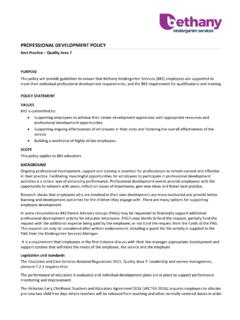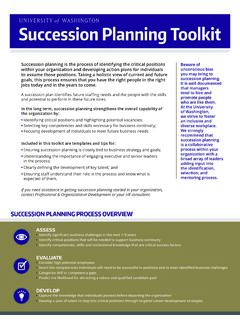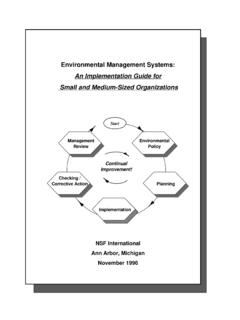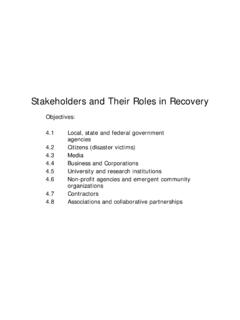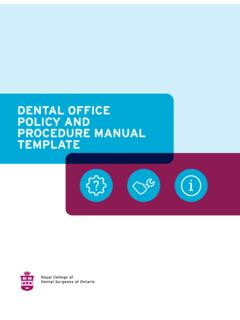Transcription of Sample Business Continuity Plan Template
1 RiskSOURCE Clark-Theders Plan The information contained in this toolkit is not intended to be used as legal advice. The reader should consult legal counsel regarding specific legal issues. 2014 Zywave Inc. All Rights Reserved. 1 Plan What is Business Continuity planning? Business Continuity planning is the process of identifying the parts of your company that are most vulnerable in order to create a plan to recover them if a Business interruption occurs. Your company s Business Continuity plan, in conjunction with Business interruption insurance, form your Business Continuity management (BCM) program. Businesses with strong BCM programs are more resilient in the face of emergencies and disasters. The steps involved in creating, implementing and maintaining a Business Continuity plan are listed to the right. The process of creating the plan is in itself a beneficial exercise. The resulting plan, if implemented and maintained, can be the difference between recovering from a Business interruption and going out of Business .
2 Why is Continuity planning important? Did you know that 1 out of every 4 businesses impacted by a disaster never reopens its doors? And in the past year, nearly 1 in 5 companies has reported experiencing a Business interruption. A Business interruption can be as benign as a short power outage or as severe as a hurricane. Companies that are prepared to face all types of incidents small or large are more likely to stay in Business . How do I use this Sample plan? This document is a Template to help you begin the Continuity planning process for your company. Sample text has been provided for the majority of the sections to serve as a starting point. You will want to review all of this Sample text and customize it to fit the needs of your company. Any text listed in red must be replaced with company-specific information. This document pairs nicely with another tool: the Business Continuity Planning Toolkit. The Toolkit provides descriptions of the purpose of each section of your Continuity plan.
3 It follows the same format as this Sample plan. Refer to the Business Continuity Planning Toolkit for additional instructions and guidance as you customize this Sample plan. You will likely find that you need to communicate with other departments or internal resources to gather the materials necessary to complete some sections of the plan. There is no need to complete the plan in the order it is listed in this Sample . Customize and adapt this Sample to fit the needs of your Business . If you have questions as you work, contact your RiskSOURCE Clark-Theders representative. 2 Plan Table of Contents Direction and Control .. 3 Business Mission Statement .. 4 Business Continuity Policy .. 4 Emergency management Group .. 4 Incident Commander .. 5 Team Processes and Procedures .. 5 Incident Commander Workflow .. 5 Emergency Operations Center .. 6 Communication .. 7 Emergency Communications .. 8 Notification .. 8 Warning.
4 8 Confidentiality Requirements .. 9 Organizational Chart .. 9 Customer Lists .. 9 Utility Provider Information .. 9 Suppliers and Equipment Providers .. 9 Life Safety .. 10 Evacuation Planning .. 11 Assembly and Accountability .. 11 Shelter .. 11 employee Training .. 12 Family Preparedness .. 12 Property Protection .. 13 Protection Systems .. 14 Mitigation .. 14 Facility Shutdown .. 15 Records Preservation .. 15 Building Information .. 16 Community Outreach .. 17 Mutual Aid Agreements .. 18 Public Information .. 18 Media Response .. 18 Local Emergency Information .. 19 Recovery and Restoration .. 20 Procurement, Logistics and Distribution .. 21 Operations .. 21 Product or Service Development .. 22 Marketing, Sales and Customer Accounts .. 22 Customer and Aftersales Services .. 23 General management and Firm Infrastructure .. 23 Human Resource management .. 24 Technology and Process Development .. 24 Implementation and Maintenance.
5 25 Integrate the Plan into Company Operations .. 26 Business Interruption Insurance .. 26 Conduct Drills and Exercises .. 26 Train Employees .. 27 Annual Plan Audit .. 28 Appendix .. 29 3 Plan Direction and Control 4 Plan Business Mission Statement <Company mission statement> Business Continuity Policy The purpose of the Business Continuity policy is to maintain Business functions in the event of an emergency. The policy applies to , its subsidiaries, all locations and all employees. In the event of an emergency, the Emergency management Group will be responsible for declaring emergencies, evacuating or shutting down facilities as necessary and contacting employees. The Emergency management Group will be led by the Incident Commander and will operate out of the designated Emergency Operations Center. The Emergency management Group has the authority to identify critical Business functions impacted by the emergency and initiate the process for recovering each function in the order laid out in the Business Continuity Plan.
6 The Business Continuity Plan is enacted with the purpose of ensuring continued Business activity in the event of an emergency and ensuring the safety of all employees. Failure to comply with the Business Continuity Plan or any directives issued by the Emergency management Group may result in verbal reprimands, official write-ups and termination, as deemed appropriate. Emergency management Group The Emergency management Group is responsible for controlling all technical aspects of emergency response. The group will be led by the Incident Commander. Members of this group (and only these designated members) have the authority to: - Order facility shutdown - Initiate evacuation of employees and customers - Declare that an incident has ended - Communicate with the media - Initiate the emergency response phone tree The following employees comprise the Emergency management Group: - < employee name and role> - < employee name and role> - < employee name and role> - < employee name and role> In the event that these individuals are not available, the following employees may serve as alternative members of the Emergency management Group: - < employee name and role> - < employee name and role> 5 Plan Incident Commander The Incident Commander is responsible for communicating with internal and external resources in the event of an emergency.
7 This individual has the authority to declare an emergency, shut down company facilities and communicate with the media. - < employee name> is the Incident Commander. - In the event that < employee name> is not available, < employee name> shall serve as the Incident Commander. Team Processes and Procedures <Team processes and procedures> Incident Commander Workflow In the aftermath of an emergency, immediately take the following steps to resume operations: - Organize a recovery team and list your Business ' top priorities for resuming operations. - Ensure the safety of personnel on the property by evaluating any remaining hazards and controlling security at the scene of the incident. - Conduct an employee briefing. - Maintain detailed records. Record all decision making and videotape or photograph the damage. - Account for all damage-related costs by establishing charge codes for purchases and repair work. - Follow your notification procedures.
8 Notify employees' families about on-duty personnel, notify off-duty personnel about their work status and alert insurance carriers and appropriate government agencies. - Protect undamaged property by closing building entrances and exits, restoring sprinkler systems, re-establishing power, guarding property against moisture and removing smoke, water and general debris. - Coordinate your restoration actions with appropriate government agencies. - Regulate salvage operations by segregating damaged property from undamaged property and retaining damaged goods until an insurance adjuster can view them. However, you should move material outside if it impedes traffic and can withstand exposure to the elements. - Perform an inventory count on damaged goods with an adjuster or the adjuster's salvor. Obtain a signed inventory listing the quantity and type of goods if you release any to the salvor. - Restore equipment and property.
9 Do not undertake any major repair work without consulting the insurance adjuster and appropriate government agencies. - Assess the value of any damaged property and the financial impact of Business interruption. - Maintain constant contact with customers and suppliers to instill confidence. 6 Plan Emergency Operations Center will designate two Emergency Operations Centers. These centers will serve as a centralized location where the Emergency management Group can gather in the event of an emergency. The primary center will be on campus and the secondary center will be located off campus. In the event that the primary center is not able to be utilized, the Emergency management Group will utilize the secondary center. Both locations will be stocked with the following resources: - Three cellphones - Three cellphone chargers - Copy of the emergency management plan - Blueprint of the facility - Map of the surrounding area - Chain of command list and contact information - Security information for the building, including the alarm code and activation/deactivation procedures - Phone tree for contacting employees - Emergency generator and gasoline - Three flashlights equipped with spare batteries - First-aid kit - 15 gallons of clean water Access to the primary and secondary Emergency Operations Centers is limited to members of the Emergency management Group.
10 The Incident Commander and the Human Resources Manager will have keys to each facility. - The primary emergency operations center is located here: <Address>. - The secondary emergency operations center is located here: <Address>. 7 Plan Communication 8 Plan Emergency Communications understands the importance of clear communication in an emergency situation. The Emergency Operations Center will be stocked with cellphones and laptops and equipped with wireless internet. It will be equipped with a backup generator to ensure Internet access even if the power goes out. Notification will ensure that all employees know the proper notification procedures for a variety of scenarios. Employees should report an emergency by contacting < employee name>. In the event < employee name> is not available, employees should contact < employee name>. To aid employees in their notification efforts, will post emergency telephone numbers <Location> and provide the emergency contact list of employees (the phone tree) <Location>.
